Digital Experience (DX)
Digital experience is the interaction a customer has with an organization on the Internet. The goal is to give the customer fast and sensible access to the things that they need in a way that is consistent with good design and expected standards. The current plan for DX is to use MCaaS as it’s managed foundation knowing well that MCaaS will have to expand the portfolio of available service; work that is currently underway.
Introduction
What is DX? The DX vision is to connect agency customers to GSA suppliers through a consistent, intuitive, and high quality centralized user interface in order to efficiently fulfill agency missions.
The problem that DX addresses is that each website initiative had their own set of styles and practices which were not consistent. The ultimate goal for DX is to create a consistent customer experience for buyers and sellers as they use FAS acquisition tools and systems when performing Market Research and Acquisition Planning.
Buy.GSA.gov is a public facing product/website created from the Digital Experience Initiative. Buy.GSA.gov serves as the user’s window or entry point into the new suite of enhanced tools and systems that provide the acquisition workforce with the most valuable features and enhanced functionalities of GSA’s best Market Research and Acquisition Planning Tools and Services.
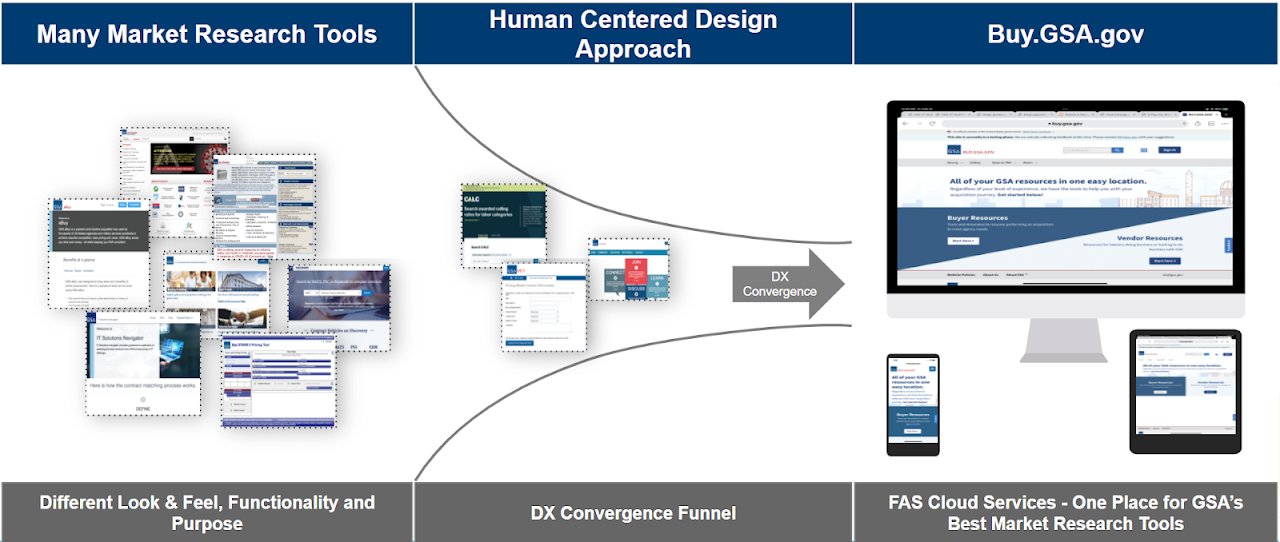
DX Architecture Overview
In September 2021 the Digital Experience (DX) platform achieved its ATO. DX is the cloud development and cloud hosting environment provided by GSA IT's FAS Cloud Services (FCS) Multi-Tenancy as a Service (MCaaS) fully-managed platform.
The architecture of the DX environment is aligned with design patterns and best practices identified in the IT Playbook. The DX environment is composed of microservices that are organized around providing business capabilities to support the "Digital Experience".
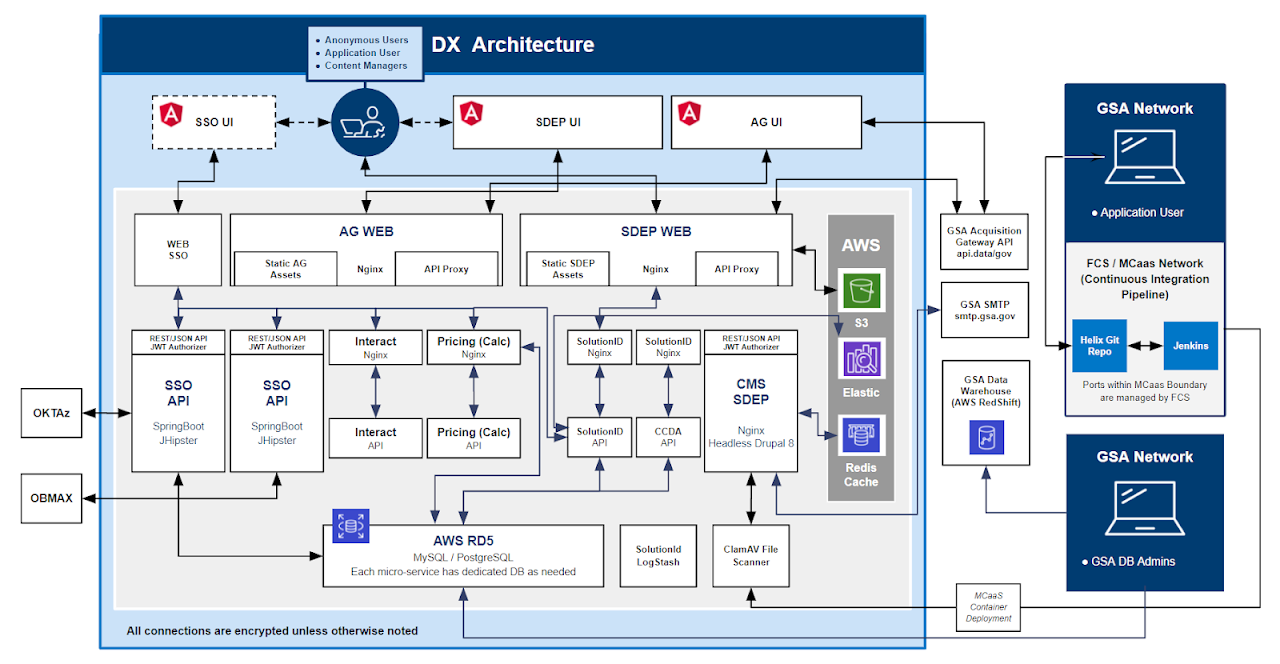
DX requires a secure, scalable and reliable environment that offers emerging technology and state of the art tools and services leveraged by the DX development teams to custom build Buy.GSA.gov.
DX employs the FCS MCaaS platform, consuming platform components as services along with AWS managed services (e.g. ElasticSearch and OpenSearch for indexing, PostgreSQL RDS data stores, S3 storage, Kafka for event queuing, and Redis and Elasticache for caching).
Beyond this, Security and DevOps tools come standard with MCaaS.
Outside of the MCaaS platform, DX uses:
-
OKTA and OMB Max to provide single-sign-on (SSO)
-
Redshift for data warehousing
-
SMTP.gsa.gov for email
-
API.data.gov for access to Acquisition Gateway
Conceptual Architecture
Logically, DX has four coarse capabilities. User Access is paramount since DX is a portal for market research. Second, DX has a service catalog that grows as each of the research tool capabilities are integrated into it. Third, DX integrates with other GSA services to bring in cogent information housed elsewhere. Last, the DX data capability ranges from provisioning to sharing and then collaboration.
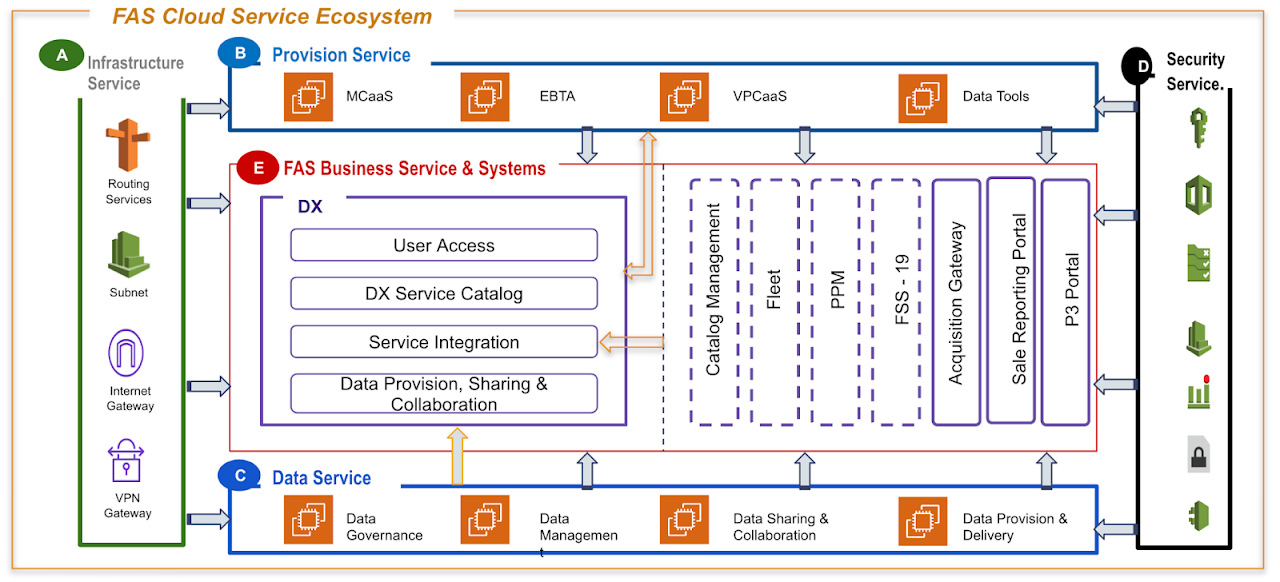
DX Logical Architecture
DX provides a clear path for content management systems to modernize.
Around DX are a host of supporting services which include networking, security, data handling and cloud infrastructure.
The DX Reference Architecture implements single page applications that hit the Single Digital Entry Point (SDEP) web application that offers up a standard API. Behind the SDEP application are the various system applications (e.g. Interact, CMS, Calc) that are similarly hosted. To move to DX, systems must comply with the DX API requirements such that the SDEP can get the appropriate information from those services.
Delivering DX Business Value by Consolidating and Enhancing FAS Market Research Tools / Systems
Currently FAS goes to market with contracts, services, tools, training and systems based on its organizational model, rather than the customer or end user experience.
As a result, the end user chooses between multiple tools that perform similar functions and are neither in sync with their buying/selling process nor a consistent look-and-feel. Based on feedback, customers want one digital location where they can buy and vendors want one place to meet those customers' needs.
Improved customer and supplier experience will lead to agencies using our solutions more often, ultimately resulting in savings for them and the American taxpayer. GSA will see increased business resulting from ease of use improvements and end user focus. Potential long-term reduction in tools O&M due to fewer tools.
The table below reflects a tools and systems convergence roadmap for all in-scope market research and acquisition planning tools and systems to be modernized and consolidated into Buy.GSA.gov. Once the most valuable features and functionality of the legacy tool / system have been converged into Buy.GSA.gov, the legacy tool / system will be decommissioned.
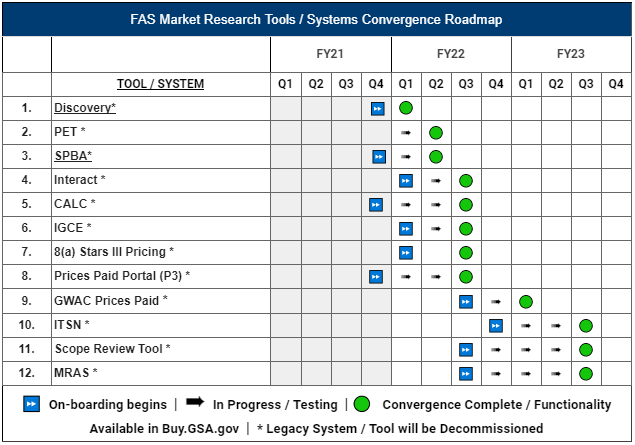
DX Single Sign On (SSO)
One of the more robust features of DX is SSO, which provides seamless user navigation between the various tools. SSO provides a layer between applications and Id Providers, enabling applications to focus on authorization and offload authentication. It also allows multiple applications to share the same authentication data for a user. The diagram below shows how we do it.
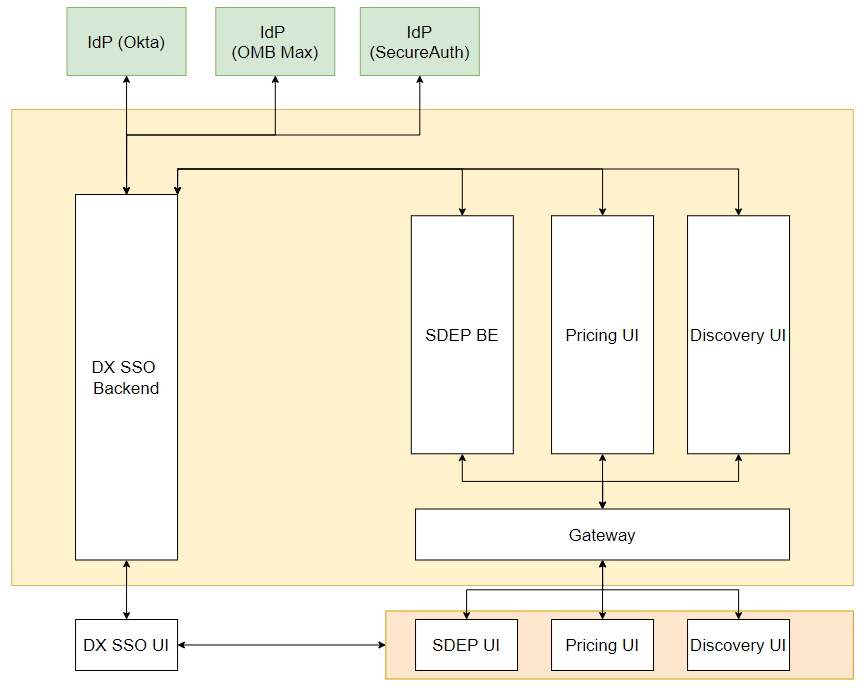
DX uses three Identification Providers (IdP): Okta, OMB Max and SecureAuth. DX SSO provides an abstraction layer giving the many IdPs one interface. The various user interfaces then use DX SSO to provide the authentication and authorization information that they need for users to navigate through their pages.

